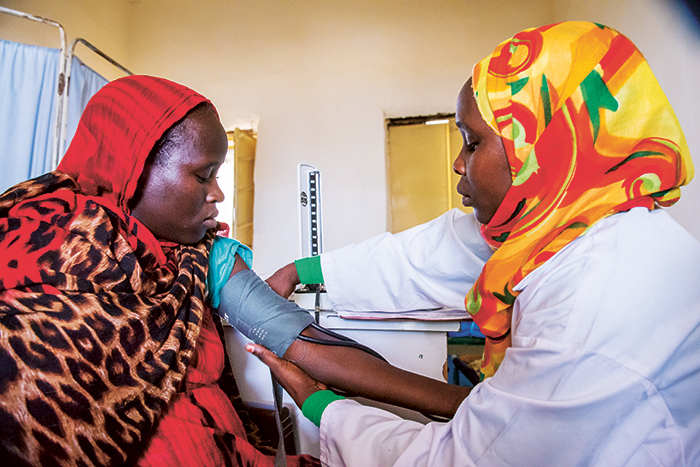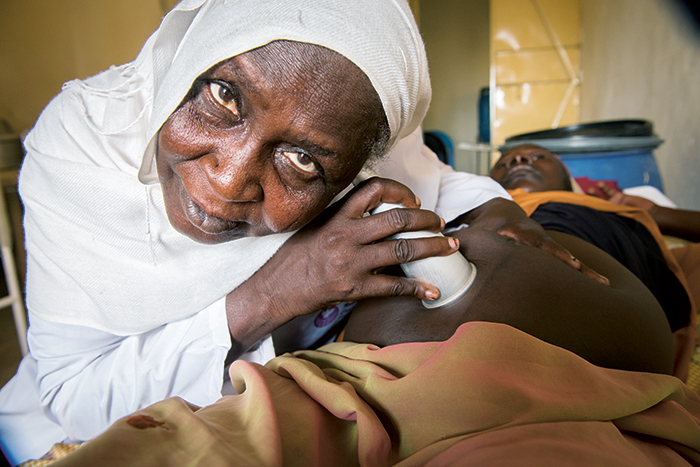
Global Report on Results

Overall goal: Improved access to quality health care for poor and marginalised communities through faith-based actors
51 Some of these rights-holders may have received health services several times.
Almost 2.4 million rights-holders received health services through NCA and partners’ efforts51. A significant increase in the availability of maternal and neonatal health services is seen in the countries where NCA and its partners implement the Access to Quality Health Care programme. This has contributed to a decrease in maternal and child mortality and a decline in the prevalence of some diseases in some target areas (like Malaria).
Strengthening Civil Society
Deviations and Lessons Learned
Global Outcome Results
Service delivery as a basis for engaging people as active citizens
Service delivery is an important part of NCA’s health programmes. During this strategy period, NCA and partners have used service delivery components strategically as a basis for engaging people as active citizens. At local level, women and men have been organised in village health committees. NCA would like to see people taking responsibility for their own health, ranging from the adoption of good hygiene practices to a village health committee taking the initiative to offer incentives to a traditional birth attendant (TBA) in order to make it more attractive for her to work in their village.
In Gogrial West County, South Sudan, 78 village health committees, established as a result of NCA and partners efforts, have been active during the period under review. NCA and partners have encouraged the village health committees to use the community conversation model as a tool to find local solutions to health problems, such as lack of access to health care. Community conversation is a local level multi-stakeholder model where everyone in the community has a legitimate voice in decision-making.
In Gogrial West County, this has resulted in increased community acceptance of the importance of pregnant women visiting health facilities for ante- and postnatal care. Another change that may be attributed to the work of the village health committees is the increased acceptance of men to accompany their pregnant wives
to facilities for antenatal visits. In Malawi and Myanmar, a change in men’s behaviour has also been observed as a result of local level engagement. In these contexts, where men rarely accompanied their wives to anteand postnatal care previously, men are now more likely to accompany their wives. This has increased men’s access to information about other health issues such as nutrition and hand washing, which in turn unexpectedly has improved their own health and increased their sense of responsibility.
A community which is better informed and aware of health issues is a healthier community. During the reporting period, health education and awarenessraising among rights-holders have been leveraged to address the lack of knowledge about health issues which too often exists in communities where NCA works. Settings for these activities have been health and nutrition facilities and home visits. In addition, awareness-raising campaigns have been carried out in the communities. The result has been both an increase in behaviour that promotes health and in the individuals’ sense of responsibility for their own well-being. In Malawi, for example, communities have on their own initiative built village meeting places where they gather for health education sessions.
52 http://www.genevaglobal.com/download/70
NCA is strongly committed to working with FBOs, who are major health providers in developing countries. WHO estimates that FBOs provide an average of about 40% of services in sub-Saharan Africa52. NCA challenges its FBO partners to employ a rights-based approach whereby rights-holders are empowered to claim their rights and duty-bearers are responsible for fulfilling them. In Zambia, NCA’s partner Churches Health Association of Zambia (CHAZ) trained staff from member church affiliated health institutions in medicine tracking, which is monitoring and auditing of services and medicines available at government run health facilities. Health centre staff has, in turn, trained community health groups in medicine tracking, and these efforts have strengthened transparency and accountability mechanisms in the Zambian health sector.

WHY: Lack of health facilities and qualified health personnel is a major problem in Kordafan state. A 2012 baseline study indicated that only nine out of 20 health care facilities functioned, none of which met the Sudanese Ministry of Health’s (SMoH) minimum standards in terms of equipment and personnel. At the functioning facilities, two physicians and 48 other health care staff served a population of 150,000.
WHAT: NCA and partners rehabilitated six health care facilities and trained new staff, including 36 who had been hired by the SMoH to the rehabilitated facilities. Fifteen traditional birth attendants (TBAs) and 50 community health workers will complete NCA and partners’ training in 2015. Five health committees were established.
RESULTS: As a result of the rehabilitated facilities and increase in trained health care personnel, there has been an increase in the frequency and quality of ante- and postnatal care.
NCA’s interventions in Kordofan have directly influenced duty-bearers to fulfil their responsibilities to provide health services for its citizens. The SMoH brought 36 new medical staff to the health care facilities rehabilitated by NCA and partner NIDAA, and this figure will significantly increase in 2015 after the training of 15 midwives and 50 community health workers has been carried out.
Five health committees initiated by NCA, with members selected by the communities, help operate the rehabilitated health facilities. They meet twice a month and have had 22 meetings either with SMoH or the local authorities over the past three years. The five established health committees have taken their role seriously and have significantly contributed to the successful operation of the facilities through a revolving medical fund that the health committees collect and oversee. The efforts of the health committees were a catalyst for the SMoH to increase the national health budget, encouraged by the health committees’ commitment and ownership of this project. Impressed by the health committee at the Hamady Health Centre, the governor of South Kordofan State recently made a commitment to increase funding for necessary upgrades at this rural health centre. Also as a result of this project are increased rates in the use of the health facilities.
In Dubeibat Rural Hospital, the average number of outpatient consultations per day has risen from an average of 19 per day before the rehabilitation to 75 after the hospital was renewed. The daily visits at the Kurkura Health Centre increased from 2-3 visits per day in 2013 to 20 following NCA’s efforts.
There have been gradual but significant improvements throughout this reporting period in ante- and postnatal care as a result of the increase of qualified midwives. Today, there are more babies delivered at the health clinics than in private homes.
The Access to Quality Health Care programme is in many ways more a collection of national health programmes than a true global programme. There were indeed some important similarities in approaches across country contexts, such as the key role played by village health committees and FBOs in many contexts. But the differing nature of the health programmes, ranging from a modern hospital for cancer treatment in Jerusalem to volunteer health workers in Eastern Myanmar, has made it challenging to identify common focus areas and working methods that a global programme can be built around.
One focus area which has progressively become more important for NCA and partners in several programme countries relates to maternal and child health. NCA will therefore take advantage of our experiences and lessons learned from this period and develop a new global programme for the next strategy focusing on reproductive health, aiming at strengthening the health situation for women and children. The role of FBOs as civil society actors in the health sector will be further strengthened in this new programme.
When it comes to country-based deviations, there were challenges in implementing some of the planned projects in Sudan as a result of an unpredictable security situation. In Darfur, insecurity occasionally has disrupted the flow of services for health clinics. The Zambia Country programme has progressively made a shift from Social Mitigation of HIV and AIDS to the Access to Quality Health Care. This is an effort to move to a more integrated response to health by addressing other community and public health issues.
All global programmes have defined global outcomes. Here is a summary of the main results per global outcome.
Achieved in Myanmar, Sudan, South Sudan, Zambia, Vietnam and Malawi. The Cross-Border Malaria Initiative in Zambia has achieved great results. Out of 12,286 households monitored, 98% were using the long lasting insecticide treated nets correctly and consistently. There was a reduction in deaths attributed to malaria in these areas. More people test themselves for malaria, an increase from 19% to 48%.
Achieved in Middle East, Myanmar, Sudan, South Sudan, Zambia and Vietnam. Both in Sudan and Darfur the continued efforts to transfer health facilities to the government have been successful. For many years the Darfur health and nutrition programme has been directly implemented by NCA, but by the end of 2014 all the staff in the clinics and nutrition centres were seconded by the Sudanese Ministry of Health.
Achieved in Vietnam, Myanmar, Middle East, South Sudan and Malawi. Training of health personnel is a key component of NCA’s Access to Quality Health Care programme. In Malawi, 1,427 Nurse and Midwife Technicians graduated from NCA partners’ nursing colleges and in Myanmar, 50 auxiliary midwifes were trained for 3 months in Thailand at the Mao Toe clinic.
Achieved in Malawi, Zambia, South Sudan, Sudan, Middle East and Myanmar. This is the outcome with best results across country programmes. Over 50,000 pregnant women were reached with antenatal clinic care and over 80,000 children under five years and newborn were reached with health services. This led to a reduction in maternal and child mortality in some target areas.
This outcome was not selected by any of the countries working on this global programme.
Achieved in Malawi and Middle East. Six Norwegian Nursing Colleges have contributed to enhance the capacity in research methods in Malawian Nursing Colleges. In addition at Augusta Victoria Hospital 53 nurses, doctors and physicians have been trained in treatment and care by Norwegian Radium Hospital.
Back